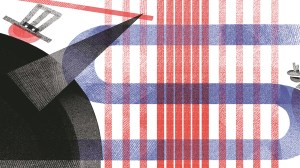Stay updated with the latest - Click here to follow us on Instagram
Wild side: Humans major threat to city’s hissing reptiles
The more plentiful group of non-venomous snakes, that include the Common Sand Boa, Rat Snake, Wolf Snake, or Indian Rock Python, are of course completely harmless.
 Russel’s Viper. (Source: Sagar Pandhi)
Russel’s Viper. (Source: Sagar Pandhi)
It’s almost axiomatic to think that snakes would dislike cities. Speeding cars, crowds of noisy people, polluted habitats — which creatures, besides humans, would want to move to a city? Yet snakes thrive in urban spaces, according to Pawan Sharma, the founder and president of Resqink Association for Wildlife Welfare (RAWW), an organisation that rescues snakes in Mumbai, among other activities. With mounds of garbage that attract rats, frogs, and lizards that ensure a continuous supply of prey, and fewer natural predators like owls, eagles, mongoose, civet cats and peacocks, many snakes prefer the relative safety of metros.
Hysterical humans remain the biggest threat to these legless, earless creatures. Even though snakes prefer to avoid confrontation and generally slink away, irrational terror, guided partly by evolutionary instinct and partly by centuries-old myths, does not go away easily. Some people end up killing the creature for no cause. At the other extreme are the foolhardy. “Many people who get bitten by a snake are drunk and try to capture it,” says Sharma. His own 20-member snake rescue team has been carefully trained by experts from the forest department. They rescue up to 600 snakes a year.
Snakes are generally not dangerous and won’t attack if they’re not provoked. That’s why snake rescuers only capture snakes when they’re in the vicinity of your car, or, say, toilet, and you really have cause for discomfort. But once the snake has been grasped by the tail and goaded, with a hook, into a snake-bag — a breathable cotton sack whose darkness proves attractive — it’s released within just three kilometers at the nearest favourable site.
 Common Krait. (Source: Sagar Pandhi)
Common Krait. (Source: Sagar Pandhi)
That’s what is deemed safe according to the International Union for Conservation of Nature’s international guidelines on wildlife rescue and management. “After all, it’s we who have encroached on their habitat,” Sharma says. “But it’s strange — we love to see a python on television, but once it’s in our garden we lose all sense. We need to coexist with these animals.”
Surprisingly, according to Sharma, doctors and herpetologists would agree that many people who have been bitten don’t die because of the immediate effects of venom (sometimes, they die even when the snake is not venomous). Rather, they succumb to heart failure — they’ve literally been scared to death. “They probably see all snakes as cobras,” says Sharma. But even the Big Four, or the most common venomous snakes – the Spectacled Cobra, the Common Krait, Russell’s Viper, and the Saw Scaled Viper — are not likely to attack you. Neither are the semi-venomous Common Cart Snake, Common Vine Snake, or Forsten’s Cat Snake.
The more plentiful group of non-venomous snakes, that include the Common Sand Boa, Rat Snake, Wolf Snake, or Indian Rock Python, are of course completely harmless. Sharma has been rescuing snakes since he was thirteen. He’s 24 now. He laments the common misunderstandings between snakes and humans that happen time and time again. “There’s such a lack of human-reptile conflict management in Mumbai,” says Sharma. “When there’s a confrontation between a human and an elephant or tiger, victims are compensated. The attack is recorded. There’s nothing like that for snakes, and that’s why we don’t have much data on the problem.”
 Saw-scaled Viper. (Source: Sagar Pandhi)
Saw-scaled Viper. (Source: Sagar Pandhi)
It’s demoralizing, says Sharma. “Even as the richest city in India, we have no centres that specialise in rescuing snakes, treating and rehabilitating them.” Even Sanjay Gandhi National Park only has a leopard rescue centre, even though there’s a high ratio of snakes recorded within the periphery of the park. And in the entire city, there isn’t a single full-time professional snake rescuer.
This lack of information and attention perpetuates negative stereotypes of what are actually fascinating, beautiful, and diverse creatures. Or, if you’re not willing to go that far, at least acknowledge that you’re a much bigger threat to them than they are to you.







